
views
- One of the best ways to determine pregnancy is to check a dog’s nipples. If they’re swollen and have a rosy hue, they’re probably pregnant.
- In the early stages of pregnancy, a dog can be lethargic, overly affectionate, and have a change in appetite.
- Veterinarians can perform invasive tests like abdominal palpation and ultrasounds to detect pregnancy, but they may not be as effective as a relaxin hormone test.
Early Signs of Pregnancy
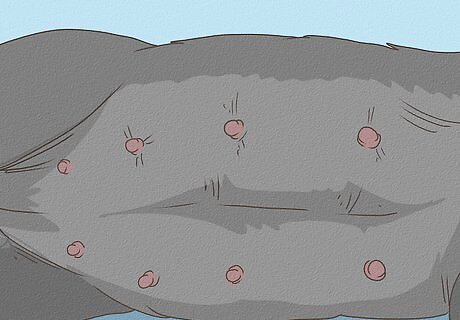
Enlarged nipples: One of the most reliable signs of pregnancy is if a female dog “pinks up” or has swollen or enlarged nipples. A pregnant dog’s nipples will become larger and rosier during the first month of pregnancy. Dogs don’t produce milk until the end of gestation or when the puppies are born; however, the nipples may leak a clear or milky discharge throughout the pregnancy.

Lethargy and behavioral changes: Monitor your dog’s activity levels to see if she’s pregnant. Some dogs may be sleepier during pregnancy, especially in the first month. They may be more affectionate and cuddly and want to play less. Your dog isn’t being lazy—she’s saving her energy to grow her puppies! For instance, if she’s napping more often and falling behind on her walks, it may be because she’s pregnant.

Changes in appetite: A pregnant dog will go through many changes, but how much food she eats may be the most obvious. In the early stages of pregnancy, your dog may eat less and experience morning sickness. By the second month, she may start eating a lot and get a bigger appetite than usual—she has more mouths to feed, after all. If your dog is constantly throwing up and eating and drinking very little, it may be a good idea to see a vet to ensure that her and her puppies are healthy.

Weight gain: If your dog is pregnant, she’ll most likely gain weight around her waist and midsection. Her expanding center is a positive sign, as healthy pregnant dogs gain 20 to 50% of their weight during pregnancy. Typically, you’ll be able to see a distended tummy when she’s 45 to 50 days pregnant.

Nesting behavior: Your dog may start moving blankets around and creating a “nest” to sleep in. She might start scratching at the floor or moving all her toys to a new place. While this behavior isn’t something you’ll notice right away, it could be a later sign that she’s preparing for her litter to come. Help your dog prepare by building her a nesting box. A cardboard box, cozy blankets, and pillows can make your pregnant dog feel comfortable and ready for what’s to come.
Testing for Pregnancy
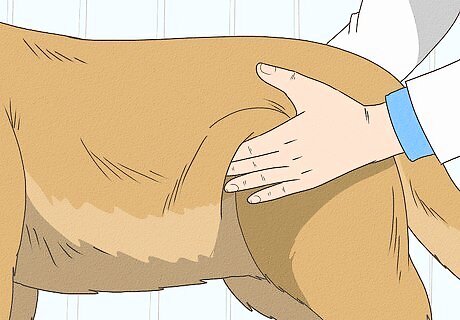
Ask your vet to perform an abdominal palpation on your dog. A vet can look for initial signs of pregnancy by massaging your dog’s abdomen. Not only is this the cheapest way to examine your dog, but it’s also less invasive. Basically, the vet will feel your dog’s stomach for the puppies. This test is the most successful between day 21 and 31 of gestation. The best time for abdominal palpation is day 28 because the puppies are now big enough to make a bump in the womb. By day 35, each puppy is surrounded by their own fluid, making it harder for a vet to accurately predict the number and size of the puppies. Keep in mind that an abdominal palpation isn’t always conclusive. Depending on your dog’s anatomy and the puppies positioning, a vet may suggest another testing option.
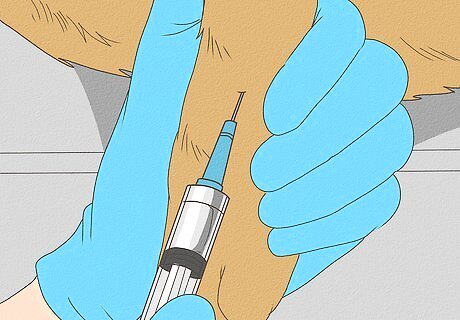
Bring your dog to the vet for a blood test. A hormone test is the most accurate way to detect canine pregnancy. A vet will take a sample of your dog’s blood and test it for the pregnancy hormone relaxin. When a dog is pregnant, relaxin releases from the placental tissue. This singular pregnancy hormone can be detected by the 30th day in a dog’s pregnancy.
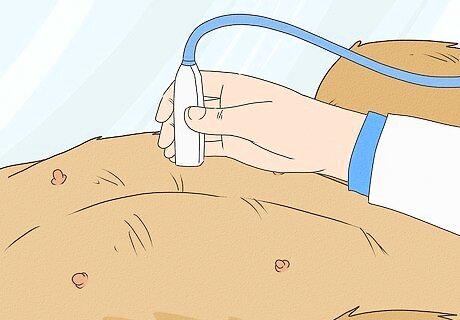
Schedule an ultrasound for your expecting dog. Ultrasound scans are the most popular and best way to detect pregnancy early on. Vets recommend scheduling your dog for an ultrasound around the 28th day of gestation. This way, they can determine the number of puppies, predict the gestational age, and detect heartbeats. Ultrasounds aren’t an invasive test, but if your dog has lots of fur, it may need to be clipped or shaven for the device to work.

Ask your vet if an X-ray will help diagnose your dog. While X-rays are not typically the first recommendation for detecting pregnancy in a dog, they can be effective during the later stages of pregnancy. These radio-active scans are an excellent way to determine the number of puppies in the litter and spot any abnormalities in the mother or puppies’s development. X-rays give the best results after day 50 of gestation, but a vet may recommend one sooner if there’s a medical complication. Sedation may be necessary when X-raying a dog, which can drop a pregnant dog’s blood pressure and put her and her puppies at risk. Radiography isn’t typically recommended unless a specific diagnosis is needed.
Knowing When Your Dog’s in Heat

Check to see if your dog is spayed or not. If you’ve had her since she was a puppy, you’ll know whether or not she’s had her uterus and fallopian tubes removed. However, if the dog came to you as an adult from a rescue center, you might not know. Take your dog to the vet just to be sure, as they can do a quick examination to see if pregnancy is possible. An unspayed dog comes into heat twice a year, so if you’ve owned her for over 9 months and she hasn’t been in heat, she’s probably been spayed. Heat is the clinical term for a female dog’s reproduction cycle. Spaying a dog is eliminates the ability to have a litter and breeding instincts. There are 4 stages in a dog’s reproductive cycle: proestrus, estrus, diestrus, and anestrus. A female dog is most likely to get pregnant in the estrus stage, which can last 3 to 4 days or 7 to 11 days. While the duration of heat depends on the individual dog, it’s usually about 18 days and starts between 6 and 24 months of age.

Look for vaginal abnormalities, like vaginal discharge. When your dog is in heat, their vaginal area will look different. An enlarged, swollen vulva (the outer part of the vagina) often starts just before heat starts. Bloody discharge occurs the first 7 to 10 days and may become a lighter color in the middle of the cycle. Place a white sheet or towel on your dog's bed to see if she’s in heat. This way, you can catch the vaginal discharge before your dog cleans herself. Dogs are most likely to get pregnant when their discharge is a lighter color, as this is a sign of ovulation.

Notice if your dog is abnormally calm or aggressive. Dogs in heat experience hormonal imbalances. Because of this, they may act differently. How your dog behaves depends on her usual demeanor and personality: if she’s usually placid, she may become short-tempered; if she’s home-loving, she may start wandering. Aside from a slight behavioral change, your dog should be in good health. If your dog lacks energy, loses her appetite, vomits, or drinks heavily, contact a vet for advice, as this may be a sign of an underlying womb condition like pyometra.
Determining the Possibility of Pregnancy
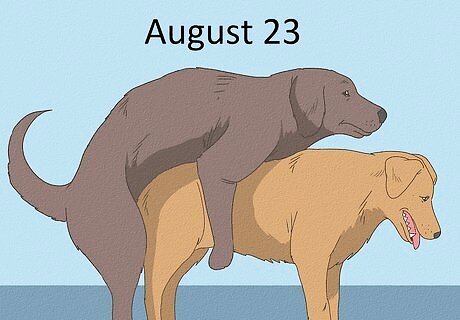
Recall when your dog was around a male dog. Female dogs can’t get pregnant on their own; they need some help from the male department. Think about the last time your dog was around other dogs, and then recall if any were male. Your dog could’ve mated with another dog at the dog park, during a playdate, or around the neighborhood.
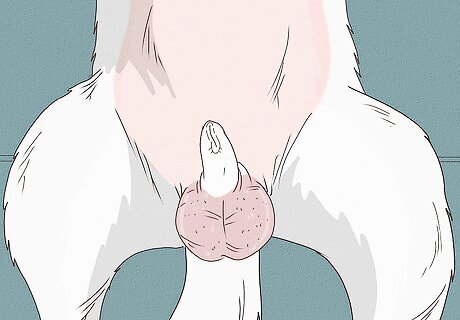
Find out if the male dog is neutered. Neutered or castrated male dogs can mate with female dogs, but they can’t impregnate her. Check-in with the suspected dog’s owner to see if they’ve been neutered. If they have, another dog may be the father; if not, they may be responsible for your dog’s future puppies. If a dog has been castrated 4 weeks before mating, there’s a very small chance that some of his sperm was left behind after the procedure, and he could impregnate another dog.

Keep a record of the date your dog mated. Having a rough estimate of when your dog mated with another dog can help you track the potential pregnancy. For instance, if she mated with a dog 3 months ago, he’s most likely not the father; however, a dog she was with 3 weeks ago may be the father. A dog's average gestation or length of pregnancy is around 63 days.
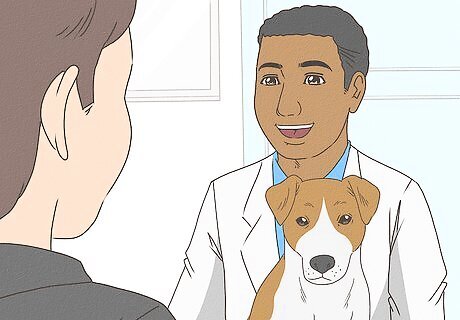
Talk to a vet about your findings to determine if your dog is pregnant. If you suspect your dog may be pregnant, bring her to the vet. Relay what you know about your dog’s heat cycle and when you suspect she mated. Based on the hormonal stage of her heat, a vet can predict the gestation of the pregnancy. From the first day of diestrus (the 3rd stage of heat), gestation is 56 to 58 days. From the initial rise in progesterone, 64 to 66 days. Keep in mind that if the dog mated but is still in heat, it’s too early to know if she’s pregnant.

Familiarize yourself with the conditions that mimic pregnancy. Believe it or not, some conditions can make a dog appear and act like she’s pregnant when she’s not, such as false pregnancies and pyometra. Pseudopregnancy or false pregnancy is often caused by a hormonal imbalance after heat and resolves itself on its own. Pyometra, on the other hand, is a bacterial infection that causes the womb to fill with pus and can be life-threatening. Pyometra can cause an enlarged stomach, extreme third, loss of appetite, blood poisoning, organ failure, and if left untreated, death. Always bring your dog to the vet if you suspect they’re pregnant, as a vet can provide life-saving treatments if necessary. Ultrasounds are the most effective way to detect false pregnancies and pyometra.




















Comments
0 comment